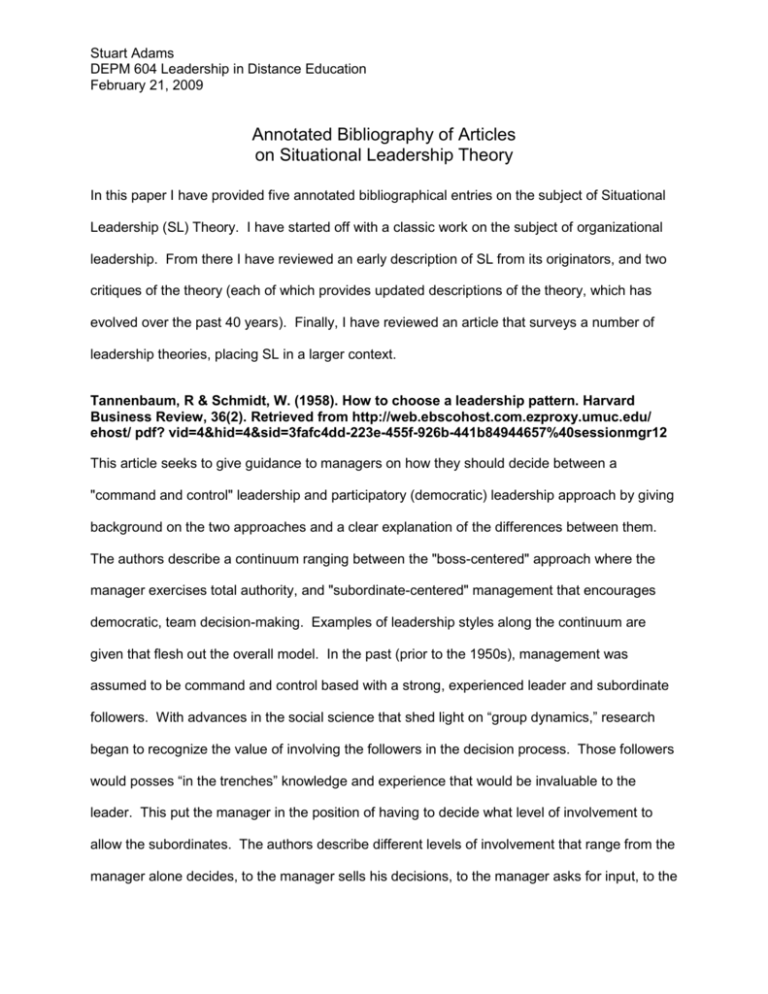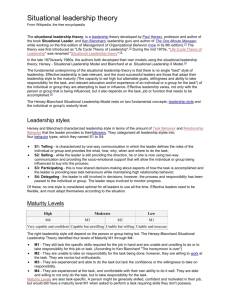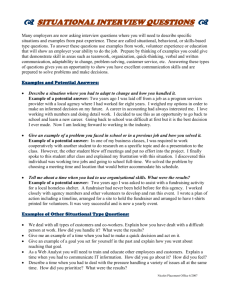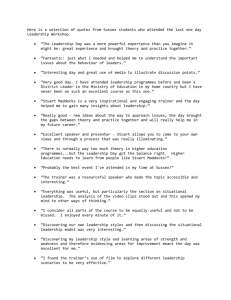604 Annotated Bibliography
advertisement

Stuart Adams DEPM 604 Leadership in Distance Education February 21, 2009 Annotated Bibliography of Articles on Situational Leadership Theory In this paper I have provided five annotated bibliographical entries on the subject of Situational Leadership (SL) Theory. I have started off with a classic work on the subject of organizational leadership. From there I have reviewed an early description of SL from its originators, and two critiques of the theory (each of which provides updated descriptions of the theory, which has evolved over the past 40 years). Finally, I have reviewed an article that surveys a number of leadership theories, placing SL in a larger context. Tannenbaum, R & Schmidt, W. (1958). How to choose a leadership pattern. Harvard Business Review, 36(2). Retrieved from http://web.ebscohost.com.ezproxy.umuc.edu/ ehost/ pdf? vid=4&hid=4&sid=3fafc4dd-223e-455f-926b-441b84944657%40sessionmgr12 This article seeks to give guidance to managers on how they should decide between a "command and control" leadership and participatory (democratic) leadership approach by giving background on the two approaches and a clear explanation of the differences between them. The authors describe a continuum ranging between the "boss-centered" approach where the manager exercises total authority, and "subordinate-centered" management that encourages democratic, team decision-making. Examples of leadership styles along the continuum are given that flesh out the overall model. In the past (prior to the 1950s), management was assumed to be command and control based with a strong, experienced leader and subordinate followers. With advances in the social science that shed light on “group dynamics,” research began to recognize the value of involving the followers in the decision process. Those followers would posses “in the trenches” knowledge and experience that would be invaluable to the leader. This put the manager in the position of having to decide what level of involvement to allow the subordinates. The authors describe different levels of involvement that range from the manager alone decides, to the manager sells his decisions, to the manager asks for input, to the Stuart Adams DEPM 604 Leadership in Distance Education February 21, 2009 manager gives control to the group to decide. Throughout this range of alternatives the manager must recognize that he never can relinquish responsibility nor give the subordinates more authority than he/she has over the decisions. The manager must decide how much involvement to allow his subordinates based on three considerations. The first of these considerations would be in the manager himself: his values, his confidence in his subordinates, his own leadership capacity, and his willingness to accept a level of insecurity. The second set of considerations would focus on the subordinates: their tolerance for uncertainty, their level of experience, and their comfort with taking on such responsibility. Final consideration would go to the situation itself: is this a situation where subordinate involvement is safe and warranted? Like John Kotter’s book, Leading Change (1996), this article is pragmatic in approach and tone and was written for the practicing manager, which could include anyone who might lead or manage the implementation of distance education. It is interesting that the most extreme example of subordinate-centered management “The manager permits the group to make decisions within prescribed limits,” represents what is now considered the norm in management. My sense is that, especially in the education field, where employees see themselves as professionals and expect a high level of autonomy, a commandbased leadership approach would fail. Another interesting note is that the authors don’t seem to make a distinction between management and leadership, a key concern in Kotter’s work. Tannenbaum and Schmidt’s seminal work, published in 1958, provides a foundational understanding of what was then considered the range of possible management styles available to the responsible manager. I have included this article as a foundational piece, a touchstone for comparison of other works on leadership, specifically situational leadership. Blanchard, K. & Hersey, P. (1970). A leadership theory for educational administration. Educ, 90(4) 303-310. Retrieved from http://web.ebscohost.com.ezproxy.umuc.edu/ ehost/pdf ?vid=6&hid =4&sid =de12bcd7-4f26-43b4-9e6c-cda29c9b034e%40sessionmgr4 Stuart Adams DEPM 604 Leadership in Distance Education February 21, 2009 This work provides an explanation of the “Life Cycle Theory of Leadership,” and gives applications in the field of the administration of education. This work is an early treatment of an idea that has come to be known as Situational Leadership Theory. The key idea is that a leader’s style should vary with the level of maturity of the “led,” whether that is a subordinate individual or a group. Maturity is meant to refer to the subordinate’s ability to act independently and responsibly, as opposed to physical or chronological age. Older theories of leadership (see Tannenbaum & Schmidt, above) viewed leadership as across a single continuum, from authoritarian to democratic. Blanchard and Hersey reject this view and state that leadership involves both a dimension of “structure” and of “consideration.” “Structure” is the level of organization and control that the leader applies in establishing behavior patterns, communications, and processes. It bears some resemblance to the single authority/democracy dimension. “Consideration” behavior refers to the level of interpersonal relationship between the leader and the led, particularly related to issues of trust and respect. It is a measure of the co-equality that the leader is willing to show the follower(s). With these definitions in place, the authors demonstrate that, with changing maturity, later refined to “task-relevant maturity,” more or less structure and consideration are applied to effect leadership. The changing maturity implying growth - of the subordinate is the source of the name “Life Cycle Theory of Leadership”. The key ideas of this theory make common sense in that different people need to be led in different ways and that the important variable is how independent and responsible the follower is. Leading post-secondary educators forward in a transformation to online learning, given their expectations of autonomy (noted above) and their varying levels of maturity, might well benefit from the application of a form of situational leadership. The examples that are given at the end of the article are interesting, not for their practical application, but as illustrations of the basic concepts of Life Cycle Theory. As a means of providing examples of the theory in action, the authors discuss life cycle theory in the educational context. They apply the theory to Stuart Adams DEPM 604 Leadership in Distance Education February 21, 2009 the teacher-student relationship, noting that lower grade-level students likely would need more structure and less consideration than senior students. The then contemporary issue of student riots on campus is used as a further application of the theory. I chose this article as a basic explanation of situational leadership. The article presents a departure from older models of leadership including Tannenbaum and Schmidt. It is an early formulation of the Situational Leadership Theory which points to its antecedents in more traditional models of leadership. As such, there is a level of continuity and historicity given. I expect that future writings by these authors will advance their ideas and expand on them (see below). Kotter discusses the role and the demands of leadership in transforming an organization (pgs 25-27), the “what” and the “why” of leadership. However, he doesn’t talk about “how” leadership is carried out. Tannenbaum and Schmidt as well as Blanchard and Hersey look at how leadership should be carried out. Theirs are valuable contributions to the larger picture. Graeff, C. (1983). The situational leadership theory: A critical view. Academy of Management Review, 8(2) 285-291. Retrieved from http://web.ebscohost.com.ezproxy .umuc.edu/ehost/pdf?vid=4&hid=4&sid=3744cfa7-8f51-413a-b07e-0c43132b4162%40 sessionmgr4 The author of this article has set about to provide an analysis and critique of the Situational Theory of Leadership as set out by Blanchard and Hersey (see above). The theory is considered in its 1977 and 1982 versions, with specific references made to each formulation. The author analyzes the theory’s normative model, which relates structure (now referred to as “task”) and consideration behavior (now “relationship”) to maturity (more specifically, now “task relevant maturity, TRM”). In addition, he analyzes the LEAD Instrument, an inventory of leadership styles. The author recognizes that leadership approaches should vary with the situation and that the subordinate/follower’s capabilities should be the key determinant in Stuart Adams DEPM 604 Leadership in Distance Education February 21, 2009 selecting a leadership approach. He then makes an “attack in detail” of the theory, that is, he identifies specific flaws and inconsistencies within the model. For example, the author identifies ambiguity in the relationship between task and relationship behavior and subordinate maturity. It is unclear t the author whether the relationship between them is curvilinear, inversely related or directly related. The author next demonstrates how Blanchard and Hersey equivocate on the meaning of relationship behavior. The author then challenges Blanchard and Hersey’s prescriptions for the loss of motivation at the higher levels of maturity. Most significantly, the author points to the lack of empirical support for the theory (see below). After the detailed analytical criticism of the normative model, the author focuses on the LEAD inventory as being ambiguous, arbitrary, and lacking sufficient theoretical justification. What the author fails to do is demonstrate that the theory’s inconsistencies and ambiguities render it invalid or, more significantly, useless. He can’t say that the variables of ability and motivation are irrelevant to identifying an appropriate leadership response to a subordinate or subordinate group. When the author presents his conclusion, it is more of a summary; no real conclusions are offered. His critiques are logical and reasonable, but what are we to do with them? Should the theory be modified in some ways that might resolve the critiques or thrown out as fatally flawed? If there are corrections and adjustments to be made, which are the most important? The author leaves us to guess. Since the author has chosen to pick apart SL theory and offers no new theory of his own, the article cannot be seen as relating to any other of our readings beyond Hersey and Blanchard’s work. I chose this article specifically to understand weaknesses of the Situational Leadership Theory, and the author has identified details that could be worked out. What remains to be understood, for my purposes, is whether the SL theory does, in fact, provide leaders with a useful model for leading individuals and groups. I see the situational leadership model as potentially being useful in gaining an understanding of “how” leading should be done most effectively. Stuart Adams DEPM 604 Leadership in Distance Education February 21, 2009 Papworth, M., Milne, D. & Boak, G. (2009). An exploratory content analysis of situational leadership. Journal of Management Development, 28(7), pp 593-606. Retrieved from http://www.emeraldinsight.com.ezproxy.umuc.edu/Insight/viewPDF.jsp?contentType=Arti cle&Filename=html/Output/Published/EmeraldFullTextArticle/Pdf/0260280703.pdf This article describes a study done to test the validity of the Situational Leadership (SL) Theory by analyzing supervisor/supervisee conversations in a hospital’s clinical supervision (CS) sessions. The authors explain that CS sessions are good examples of leadership in action and so are useful as a study context. The article includes an overview of Hersey and Blanchard’s SL theory. (Note that some refinements have been made and nomenclature changed from the theory as discussed above. “Readiness” has replaced “maturity.”) A review of previous studies testing support for the theory based on empirical evidence are presented; those study’s results generally give indeterminate but low support for key aspects of the theory. This study’s approach is a behavioral science technique called content analysis, a quantitative analysis method that tracks the content of specific text or speech, in this case supervisor/supervisee conversations. A description of the study’s method and analytical approach were presented. The study also includes what the authors refer to as a micro-analysis, where they look at the flow of a single conversation to identify behaviors that support or challenge the theory. A key point is that the conversations that were analyzed were viewed as examples of successful leadership by the supervisor that conducted them. Thus, the content analysis that assessed whether there was a correlation between the levels of maturity/readiness level and the approaches to leadership could be considered valid. Only three levels of “readiness” were included in the study. For each of the three levels analyzed, the expected leadership approach in most cases was not matched to the actual readiness level of the subordinate, in conflict with the theory’s prediction. There was a relationship between the readiness level and the ratio of supervisor vs. supervisee speech in the conversations. Further, the study demonstrated that supervisors move between each of the leadership styles throughout the conversations rather Stuart Adams DEPM 604 Leadership in Distance Education February 21, 2009 than using only one style as the theory predicts. Based on these results, the authors found limited support for the theory. Most of the predicted behaviors did not occur. These findings were consistent with other studies reviewed in the article. Significantly, the article does offer directions wherein the theory might further be refined which are discussed below. The article also notes limitations to the study, including its small sample size, the absence of even a single high-readiness subject, the likely complexity of the conversation material, and the biases that might come with a self-selecting study group. Thus, the article describes the study as “exploratory.” This study is applicable to distance education in that it calls into question the actual effectiveness of SL, challenging whether it is useful in any context. This article provided me with a description of the further updated version of the theory and presented a thoughtful assessment of the validity of the theory based on empirical evidence. As such it was a continuation of the intellectual dialog on the value of SL theory. Beyond the central finding of low empirical support for the theory, what was most interesting were the suggestions offered as to how the theory might be further explored. The idea that an individual’s readiness/maturity might be different under varying circumstances is compelling as is the suggestion that supervision might be different for the different levels of complexity of each specific task being supervised. I would expect that in a subject as complex and multi-variant as leadership (as with any aspect of interpersonal relationships) there might be varying levels of detail and a complexity in the way approaches are applied. One other small area of interest to me was how a management activity, which the CS sessions epitomized, was considered a test of leadership theory, blurring the distinction between the two. (2005). Chapter TWO: Leadership theories, role models - and common sense. (pp. 29-47). Thorogood Publishing Ltd. Retrieved from http://ezproxy.umuc.edu/login?url=http: //search.ebscohost.com/login.aspx?direct=true&db=bth&AN=22377335&loginpage=login. asp&site=ehost-live&scope=site Stuart Adams DEPM 604 Leadership in Distance Education February 21, 2009 This article is the second chapter in the book Leadership for Leaders which discusses core competencies of leadership in business. This chapter provides an overview of some currently accepted models of leadership, discusses the concept of “Low-key ‘thinking’ leadership, and relates leadership theory to practice and experience. The first theory considered is John Adair’s “Action-centered Leadership.” Adair states that effective leadership balances the Task, the Team, and the Individual’s needs to achieve goals. Next, Situational Leadership Theory is examined. The familiar elements of maturity driving the choice of leadership style are explained and praised. Noel Tichy’s “Leadership Engine” is covered next. The ‘Engine’ has three facets: ideas, values, and what Tichy calls the ‘E3 Factor.’ E3 stands for Emotion, Energy, and ‘the Edge’ – that decisive, bold, “can-do” spirit that animates effective leaders. Finally, Jim Collins’ research-based model of ”Level 5” leadership is discussed. Collins’ Level 5 model starts with the idea that leadership success depends first on getting the right people on the team before deciding what to do. Level 5 leaders ask hard question, sometimes goring sacred cows but always moving in the direction of greatness for the organization. Collins also raise the issue of what the organization shouldn’t be doing along with the question of what they should be doing, recognizing that leadership must boldly reduce organizational time-wasters. We learn from Collins of the “Hedgehog concept,” that of recognizing the “one thing” that the leader and the organization must focus on to be successful. Finally, Level 5 leadership is concerned with the leaders’ balancing of personal drive with personal humility, to avoid bringing too much focus on oneself. The chapter then discusses the idea of “low-key thinking leadership,” which is leadership that doesn’t call too much attention to itself, but delivers focused action towards the advancing of the organization. The remainder of the chapter considers the balance between practical experience and leadership theory. Overall, this work was of lower scholarly value than the other works that I have read on the subject. However, it serves the function of placing Situational Leadership Theory within a Stuart Adams DEPM 604 Leadership in Distance Education February 21, 2009 larger context of theories of leadership and provides a number of answers to the question of “how” to lead to match Kotter’s “what” and “why” of leadership. In fact, SL is one of many theories, each of which has apparent validity when viewed from a common sense perspective and may be applicable in attempting transformational change to distance education. Any of the theories might be applicable to leadership of distance education. I found it interesting that, in providing an inventory of important leadership models, the author did not mention old-fashioned command and control leadership as a leadership approach. Though considered outmoded, this model ought to be considered a sort of a baseline for other theories. The author makes a valid point on the value of theories, quoting Professor Barry Turner “There is nothing so practical as a theory that works.” Often, theory is treated as an irrelevant waste of time, but a good theory can give perspective and a larger meaning to practical activities.




